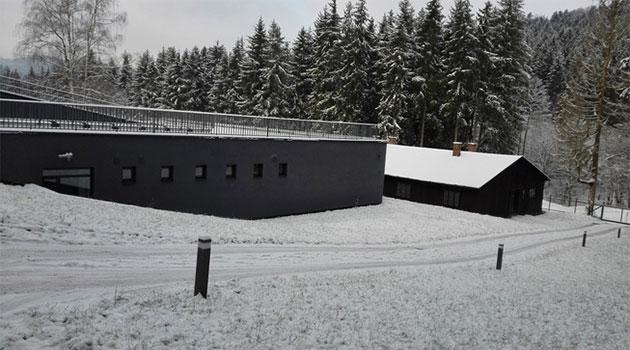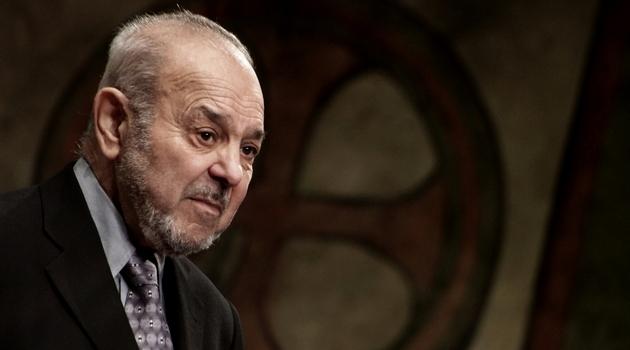Czech Museum of Romani Culture officially takes charge of memorial at Romani genocide site in Hodonín u Kunštátu

Today the Museum of Romani Culture is scheduled to officially take over the grounds of the memorial at the Romani genocide site in Hodonín u Kunštátu from the Office for Government Representation in Property Affairs (ÚZSVM). The Museum will become the administrator of the entire site and will be in charge of running the memorial for the public, including building its exhibitions.
Kristina Kohoutová of the Museum informed news server Romea.cz of the scheduled handover on 20 January. A press conference in the lecture hall of the memorial and a guided tour of the entire grounds was scheduled.
Currently an information center occupies the site, comprised of an entry building with an exhibition space and lecture hall, accommodation for the administrator and guide, and an outdoor amphitheater. It is also possible to view a replica of the barracks for the prisoners and an original, preserved barracks for the guards, as well as a modified floor plan of what was once the so-called “Gypsy Camp”.
“The original, preserved building of the prisoner’s barracks was in bad condition and therefore it apparently was necessary to demolish the original and produce a faithful replica of it. Nevertheless, the original barracks for the guards managed to be preserved as evidence of the past for future generations to recall the tragic history of this location and the Romani nation,” Museum director Jana Horváthová said.
The memorial cost almost CZK 100 million [EUR 3.9 million] to build at the site of the Protectorate-era concentration camp for Romani people. Construction work on the memorial took five years and an exhibition reminding viewers of the fate of the Roma during the Second World War will be installed there.
The building of the memorial was performed by the Comenius National Pedagogical Museum and Library, which was also meant to create the exhibition and open it to the public last year. “The National Pedagogical Museum never finished building the memorial and for that reason all planned exhibitions are still missing there,” Kohoutová told news server Romea.cz previously.
The Museum of Romani Culture is creating those exhibitions now. Not far from the memorial is the remembrance site of Žalov, where the mass graves of the camp’s victims are located and where a metal cross with Romani symbols designed by Romani stonecutter Eduard Oláh has been installed.
The handover of the memorial to the Museum of Romani Culture was approved in September by the Government. The move fulfilled one of the measures approved as part of its Romani Integration Strategy to 2020.
BRIEF HISTORY OF THE LOCATION BEGINNING IN 1940
Not far from Kunštát there was once an internment center where people who were considered inconvenient were concentrated by the various regimes in charge from 1940 to 1950. From 1940 to 1942 the location served as what was called a Disciplinary Labor Camp.
From August 1942 until December 1943 the grounds were run as a “Gypsy Camp” where Romani people were concentrated before being transported to Auschwitz. The same purpose was also served by a similar camp at Lety u Písku in Bohemia.
The camp near Kunštát saw 1 396 people pass through its gates, and 207 children, men and women died in the camp itself. In 1944 it became a Disciplinary Labor Camp again and housed prisoners as such.
Before the end of the Second World War, Wehrmacht members performed military exercises on the grounds of the camp. In May and June of 1945 Romanian Army soldiers stayed on the grounds, and in the summer of 1945 the facility served as an isolation hospital for the Red Army of the USSR.
1948 – 1995
After the communist putsch in Czechoslovakia, the center served as a forced labor camp again. Later the facility at Hodonín was used as a recreation center.
The grounds served as a recreation facility for the Revolutionary Trade Union Movement (ROH) members working at the Maloměřice Cement Factory in Brno for the children of the employees there. Many new buildings were constructed to replace the original ones.
By the beginning of the 1980s a heated outdoor swimming pool had been built there. After November 1989 the facility was privatized.
After several years, what was called the Žalov Recreation Center was built over the floor plan of the former concentration camp. The grounds featured a restaurant, a swimming pool, and the opportunity to stay there year-round in small cottages.
In 1995 the Museum of Romani Culture, in cooperation with the then-Mayor of Hodonín, Mr Miroslav Plíhal, began to hold commemorative ceremonies honoring the memory of those who died at or as a result of their imprisonment in the “Gypsy Camp” at Hodonín u Kunštátu. The tradition of commemorative ceremonies at the site became established, and in 1997 the Museum of Romani Culture unveiled a memorial at Žalov, a metal cross with Romani symbols made by Romani stonecutter Eduard Oláh, followed one year later by the installation of a memorial plaque designed by the visually impaired Romani sculptor Božena Vavreková (Přibylová) at the cemetery in neighboring Černovice.
At that same time the Museum began its efforts to see the entire grounds of the former concentration camp become a remembrance site. The recreation facility was still in operation there.
2009 – 2017
At the beginning of February 2009, Czech Human Rights Minister Michael Kocáb reached a preliminary agreement with the owner of the recreation facility, Alena Vojtová, for the state to buy her out. The National Pedagogical Museum and J. A. Comenius Library was entrusted with building a Romani Holocaust Memorial there by a Czech Government Decree, No. 158 of 2 March 2011, which amended the Czech Government Decree of 4 May 2009 (No. 589) on the adaptation of the remembrance sites at Hodonín u Kunštátu and Lety u Písku.
In 2016 the construction work managed to be completed at what was now being called the Hodonín u Kunštátu Memorial, and in 2017 the long-term professional activity involved in building its exhibition for the public and adapting the grounds so that visitors could recognize what the original concentration camp for Romani prisoners from 1942-1943 there looked like also came to an end. The exhibition was not completed at that time.
In December 2017 it was decided that the administrator of the memorial would be changed, and on 4 December 2017 a contract was signed between the Comenius National Pedagogical Museum and Library and the Office for Government Representation in Property Affairs (ÚZSVM) on transferring the state’s property, i.e., the grounds of the Hodonín u Kunštátu Memorial, back to the ÚZSVM. As of 25 January 2018 the administrator of the memorial will be the Museum of Romani Culture.
